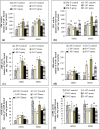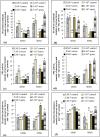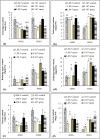Foliar treatment of potassium nitrate modulates the fermentative and sucrose metabolizing pathways in contrasting maize genotypes under water logging stress
- PMID: 32377040
- PMCID: PMC7196593
- DOI: 10.1007/s12298-020-00779-1
Foliar treatment of potassium nitrate modulates the fermentative and sucrose metabolizing pathways in contrasting maize genotypes under water logging stress
Abstract
The effect of potassium nitrate on the status of fermentative and sucrose metabolizing pathways was studied in two maize (Zea mays L.) genotypes, viz., LM 5 (relatively susceptible to flooding) and I 167 (relatively tolerant to flooding) under water logging stress. The higher increase in pyruvate decarboxylase, alcohol dehydrogenase and aldehyde dehydrogenase activities in the hypoxic roots of I 167 seedlings over LM 5 showed the former's efficient tolerance mechanism towards anaerobic conditions. Foliar application of KNO3 reduced these enzymatic activities in the roots of both the genotypes. The shoots of I 167 seedlings also showed a parallel increase in alcohol dehydrogenase and pyruvate decarboxylase activities under water logging stress. These enzymatic activities, however, remained unaffected in shoots of water logged LM 5 seedlings. There was a higher decrease in acid and alkaline invertase activities in the hypoxic roots of I 167 seedlings. KNO3 treatment led to higher acid invertase activity in roots of I 167 seedlings than those of LM 5. Sucrose synthase (synthesis) and sucrose phosphate synthase activities decreased, but sucrose synthase (breakdown) activity increased in the roots of both the genotypes, during water logging. KNO3 increased sucrose synthesizing activities with a parallel increase in the sucrose content of the roots. Sucrose synthesis was comparatively unaffected in I 167 shoots under water logging stress while LM 5 shoots showed higher reduction in its sucrose synthase (synthesis) and sucrose phosphate synthase activities. It may thus be concluded that KNO3 induced a network of reactions for improving water logging tolerance. The nitrate ions acted as an alternate electron acceptor and thus reduced the activities of fermentative enzymes. It promoted the funneling of sugars into the glycolytic pathway by inducing the activities of acid and alkaline invertases in the roots and shoots of maize genotypes. It also directed the hexoses towards biosynthetic pathway by increasing the activities of sucrose synthesizing enzymes.
Keywords: Fermentative pathway; Potassium nitrate; Sucrose metabolism; Water logging.
© Prof. H.S. Srivastava Foundation for Science and Society 2020.
Conflict of interest statement
Conflict of interestThe authors declare that there is no conflict of interest.
Figures




References
-
- Aggarwal PK, Kalra N, Chander S, Pathak H. Infocrop: a dynamic simulation model for the assessment of crop yields, losses due to pests, and environmental impact of agro-ecosystems in tropical environments. I. Model description. Agric Syst. 2006;89:1–25. doi: 10.1016/j.agsy.2005.08.001. - DOI
-
- Carvalho PAD, Oliveria LEMD, Domiciano D, Carvalho JND, Prodente DDO, Guimaraes RJ. Effect of nitrogen source and oxygen deficiency on carbon metabolism and antioxidant system of rubber tree plants (Hevea spp.) Aust J Crop Sci. 2018 doi: 10.21475/ajcs.18.12.01.pne774. - DOI
-
- Crawford RMM, Braendle R. Oxygen deprivation stress in a changing environment. J Exp Bot. 1996;47:145–159. doi: 10.1093/jxb/47.2.145. - DOI
LinkOut - more resources
Full Text Sources
